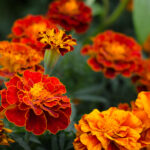
Large Patch is fungus that begins developing when soil temperatures start dipping down to 70°F. Usually this occurs in the fall, but you may not notice the symptoms until the spring when the temperatures start to rise and the grass is greening up. Symptoms of this fungi are circular patches of light brown grass. Large patch is caused by too much nitrogen in the fall and spring, poor soil drainage, over-irrigation, excessive thatch accumulations and low mowing heights.
How to control Large Patch:
- Select a disease-resistant grass. Warm season grasses such as Centipede, St. Augustine and Zoysia are more susceptible than Bermuda.
- Cultural control such as applying fertilizer and avoiding nitrogen application in fall and spring.
- Water as needed to prevent drought and install proper drainage to avoid extended periods of saturated soil.
- Control traffic patterns to prevent severe compaction and aerate as needed to maintain soil drainage.
- Mowing high and powering raking needed to control thatch accumulations.
- Applying a fungicide controls the disease for several weeks.






